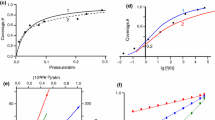Abstract
The main quantitative results from Wagner's oxidation theory are recalled while the conditions of application of that theory are reviewed from the point of view of oxidation kinetics like those of chromium, zinc, and iron. Bibliographical results on cobalt and copper oxidation and on cobaltous and cuprous oxides are quantitatively compared to Wagner's theory. In the same, the validity of the cation self-diffusion coefficient determination by the parabolic constant is considered. Finally, the modification of a rate equation to take a surface reaction into account is discussed.
Similar content being viewed by others
Abbreviations
- D :
-
Ion self-diffusion coefficient
- D o :
-
Ion self-diffusion coefficient at unit oxygen pressure
- E :
-
Activation energy
- N v :
-
Vacancy concentration
- N t :
-
Number of cation sites per unit volume
- X :
-
Scale thickness at timet
- a o :
-
Oxygen activity inside the scale
- C eq :
-
Concentration of oxide equivalent as defined by Wagner
- k :
-
Oxidation parabolic constant as defined by Eq. (1)
- k r :
-
Oxidation rational constant as defined by Wagner
- n :
-
Coefficient used to describe any variable as a function of\(p_{{\text{O}}_{\text{2}} }^{{{\text{1}} \mathord{\left/ {\vphantom {{\text{1}} n}} \right. \kern-\nulldelimiterspace} n}} \)
- n D :
-
Diffusion coefficient dependency on\(p_{{\text{O}}_{\text{2}} } \)
- n x :
-
Nonstoichiometry dependency on\(p_{{\text{O}}_{\text{2}} } \)
- n k :
-
Parabolic constant dependency on\(p_{{\text{O}}_{\text{2}} } \)
- n σ :
-
Electrical conductivity dependency on\(p_{{\text{O}}_{\text{2}} } \)
- \(p_{{\text{O}}_{\text{2}} } \) :
-
Oxygen pressure at equilibrium
- t :
-
Time
- Z :
-
Cation or anion average valency in the oxide
- x :
-
Degree of nonstoichiometry as defined by M1−xO or M2−xO
- σ :
-
Electrical conductivity
- v i :
-
Stoichiometric coefficient
- μ i :
-
Chemical potential of chemical species i
- 1:
-
Subscript used for cation
- 2:
-
Subscript used for anion
- ′:
-
Superscript used for the metal-oxide interface
- ″:
-
Superscript used for the oxide-gas interface
- □:
-
Ion vacancy
References
C. Wagner,Z. Physik Chem. B21, 25 (1933).
C. Wagner,Z. Physik. Chem. B32, 447 (1936).
C. Wagner and K. Grunewald,Z. Physik. Chem. B40, 455 (1938).
R. E. Carter and F. D. Richardson,J. Metals 7, 336 (1955).
O. Kubachewski and B. E. Hopkins,Oxidation of Metals and Alloys, 2nd ed. (Butterworths, London, 1962), p. 222.
J. Benard,l'Oxydation des Métaux, Vol. II (Gauthier et Villars, Paris, 1964).
H. J. Grabke, K. J. Best, and A. Gala,Werkstoffe und Korrosion 21, 911 (1970).
L. Himmel, R. F. Mehl, and G. E. Birchenall,J. Metals 5, 827 (1953).
C. Wagner,Atom Movements (A.S.M., Cleveland, 1951), p. 153.
P. Kofstad,High Temperature Oxidation of Metals (John Wiley and Sons, New York, 1966), p. 125.
B. Fisher and D. S. Tannhauser,J. Electrochem. Soc. 111, 1194 (1964).
C. Wagner and H. Hammen,Z. Physik. Chem. B40, 197 (1938).
M. O'Keffe and W. J. Moore,J. Chem. Phys. 35, 1324 (1961).
J. Gundermann, K. Hauffe, and C. Wagner,Z. Physik. Chem. B37, 148 (1937).
R. S. Troth, R. Kilkson, and D. Trivich,Phys. Rev. 122, 482 (1961).
M. O'Keffe and W. J. Moore,J. Chem. Phys. 36, 3009 (1962).
J. K. Lee and W. J. Moore, as cited in ref. 21.
J. P. Baur, D. W. Bridges, and W. M. Fassell,J. Electrochem. Soc. 103, 273 (1956).
S. Mrowec and A. Stoklosa,Oxidation of Metals 3, 292 (1971).
S. Mrowec and A. Stoklosa,Werkstoffe und Korrosion 21, 934 (1970).
W. J. Moore and B. Selikson,J. Chem. Phys. 19, 1539 (1951);20, 927 (1952).
J. Gundermann and C. Wagner,Z. Physik. Chem. B37, 155 (1937).
K. Fueki and J. B. Wagner,J. Electrochem. Soc. 112, 384 (1965).
S. Mrowec, T. Walec, and T. Werber,Corrosion Sci. 6, 287 (1966).
W. B. Jepson,J. Electrochem. Soc. 107, 53 (1960).
D. W. Bridges, J. Baur, and W. Fassel,J. Electrochem. Soc. 103, 614 (1956).
N. F. Mott and R. W. Gurney,Electronic Processes in Ionic Crystals, 2nd ed. (Clarendon Press, London, 1948), p. 257.
F. Morin and M. Rigaud,Can. Met. Quart. 9, 521 (1970).
W. K. Chen, N. L. Peterson, and W. T. Reeves,Phys. Rev. 186, 887 (1969).
N. G. Eror and J. B. Wagner,J. Phys. Chem. Solids 29, 1597 (1968).
D. W. Bridges and W. M. Fassell,Oxidation of Metals 1, 279 (1969).
Author information
Authors and Affiliations
Rights and permissions
About this article
Cite this article
Morin, F., Beranger, G. & Lacombe, P. Limits of application for Wagner's oxidation theory. Oxid Met 4, 51–62 (1972). https://doi.org/10.1007/BF00612507
Received:
Revised:
Issue Date:
DOI: https://doi.org/10.1007/BF00612507




